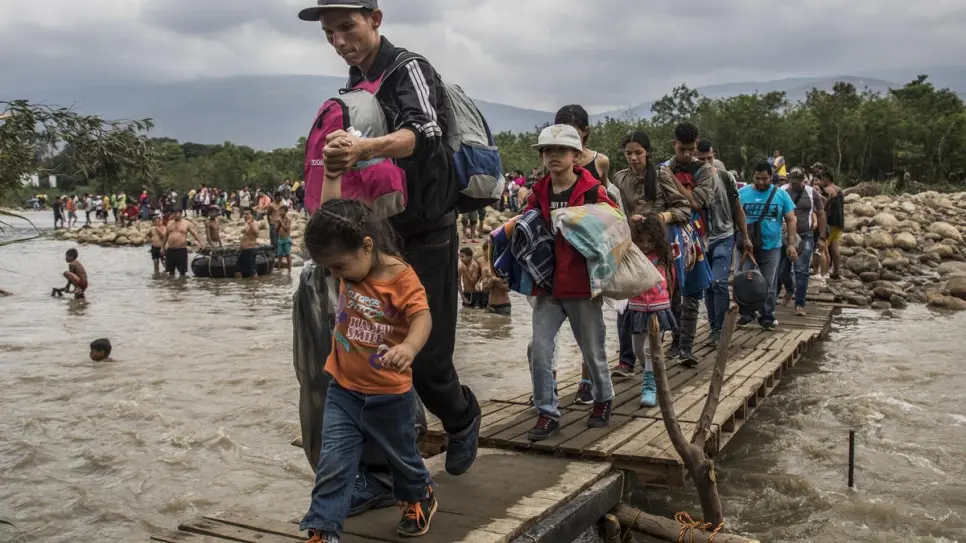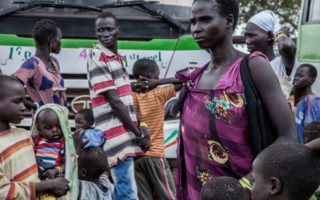
Venezuelans cross the Tachira River to reach Colombia in April 2019. © UNHCR/Vincent Tremeau
UNHCR’s annual Global Trends report finds more people are fleeing war, conflict and persecution worldwide. For many, rebuilding their lives remains out of reach.
One per cent of the world’s population has been forced to flee their homes due to war, conflict and persecution to seek safety either somewhere within their country or in another country, according to the latest Global Trends report released today by UNHCR, the UN Refugee Agency.
As more people became displaced than at any time since UNHCR began issuing its annual study, fewer and fewer were able to return home – or even build sustainable, fulfilling new lives in another country.
“We are witnessing a changed reality in that forced displacement nowadays is not only vastly more widespread but is simply no longer a short-term and temporary phenomenon,” said UN High Commissioner for Refugees Filippo Grandi.
At the end of 2019, there were 79.5 million people around the world who had been forcibly displaced, according to the yearly report, up from 70.8 million the year before. The rise was in part due to worrying new displacement in places such as the Democratic Republic of the Congo, the Sahel region of Africa, Yemen and Syria. It also reflected the inclusion for the first time of 3.6 million Venezuelans who have been displaced outside their country but who have not sought asylum.
By the end of 2019, a total of 4.5 million people had fled Venezuela, the region’s biggest exodus in recent history and one of the largest displacement crises in the world. Most sought refuge in Latin America or the Caribbean.
Last year, Yosanni Martínez, 28, joined the millions of people forced to flee the country’s economic and political instability. She took a bus to the Brazilian border with her brother, then walked for six days to the city of Boa Vista in northern Brazil. Her son slept in his stroller each night as she and her brother slept on the ground.
“We fled Venezuela because I have a disabled child. He has cerebral palsy. There were no health-care options, or food or any of the medical items we needed,” said Yosanni, who took a job at an inn to save money so her husband and other family members could join her in Brazil. “Sometimes I feel defeated, but I am sure things will change and get better.”
There were 29.6 million refugees or others displaced outside their country at the end of 2019, and 45.7 million people who had sought refuge within their own country. Nearly 4.2 million additional people were awaiting the outcome of asylum cases.
More than two-thirds of the world’s refugees or others displaced outside their country came from only five countries: Syria, Venezuela, Afghanistan, South Sudan and Myanmar. And the world’s poorest countries continued to host the majority of refugees.
As conflicts dragged on and many countries tightened their borders, finding long-term solutions for refugees – whether it meant helping them return home safely and voluntarily, integrate into local culture in a host country, or resettle in a third country – proved increasingly difficult.
Over the last decade, only four million refugees were able to return to their native countries, compared with 10 million the previous decade. Roughly 0.5 per cent of the world’s refugees were offered resettlement in 2019.
The problem of displacement shows no sign of abating, as climate change, hunger and conflict contribute to increasingly complex crises. As the world grapples with the economic and social devastation of the COVID-19 pandemic and rising xenophobia, and countries continue to restrict entry – the problem of finding long-lasting solutions for refugees is becoming acute.
“We need a fundamentally new and more accepting attitude towards all who flee, coupled with a much more determined drive to unlock conflicts that go on for years and that are at the root of such immense suffering,” Grandi said. “People cannot be expected to live in a state of upheaval for years on end, without a chance of going home, nor a hope of building a future where they are.”
“If it is safe, we would go back in a heartbeat.”
As the conflict in Syria ground on, the country continued to account for the largest number of refugees, asylum-seekers and internally displaced people – 13.2 million in total, roughly one sixth of the world’s forcibly displaced people. Syrian refugees who fled to neighbouring countries struggled with the trauma of protracted displacement.
Ahmad (43) and Fahemyh Hussain (42) fled Aleppo, Syria, in 2016 when the bombing became so bad they had to leave or die. They found safety in Amman, Jordan. Ahmad still remembers the relief he felt when his seven children fell asleep peacefully during the first night in the Azraq refugee camp. But four years later, the strain of living in the camp, especially during a COVID-19 lockdown, has proven almost unbearable, he said.
“I want to provide for my family, to be a father. Sometimes I wish that we could live in a normal apartment again, live outside a refugee camp, and that I had a job to go to every morning,” he said. “At least here we have shelter and the children can go to school. Of course, if there is ever the possibility to go back to Syria, if it is safe, we would go back in a heartbeat.”
Additional writing and reporting by Sarah Schafer in New York, Victoria Hugueney in Brasilia and Lilly Carlisle in Amman, Jordan.
Originally published on UNHCR on 18 June 2020





